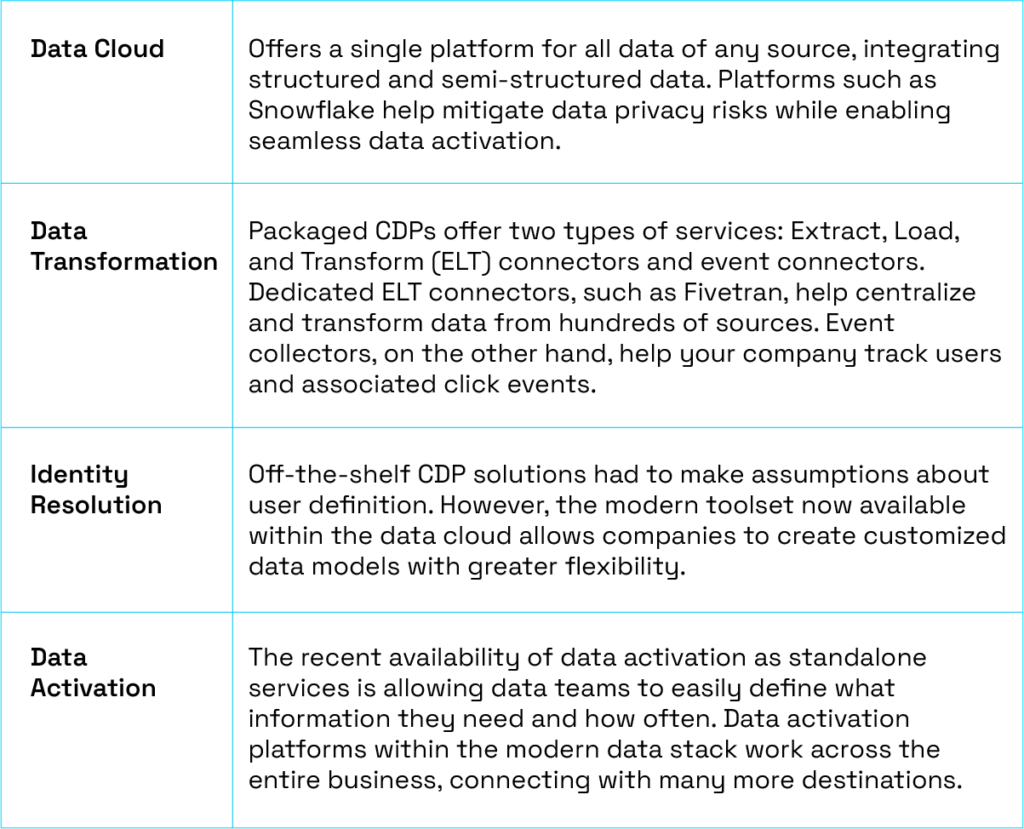Many marketers around the world consider adaptation as one of their main challenges. This is, according to an Oracle report on Marketing Trends 2022, a balancing act: managing “customers’ desires against their need for agility and adaptability”. Customer data platforms (CDP) have arrived as a way to integrate many needs into a single, streamlined process.
The Customer Data Platform Institute defines such a product as a “packaged software that creates a persistent, unified customer database that is accessible to other systems”. This all-in-one-platform serves as a database for marketing teams to store customer information and thus leverage marketing automation.
Although CPD may seem like the holy grail of marketing solutions, its implementation can be quite challenging. Engineering teams must first implement data collection through numerous events, backend services and apps —a process that can often take from three to six months. Moreover, most CDPs often miss key data from outside the applications a company uses.
The composable CDP has entered the market as an evolution on the traditional platform by working with the organization’s cloud data platform and using best-in-class components for every step. In this blog, we’ll explore how composable CDPs are changing the game and explain how Hakkoda is leveraging this technology to solve the many challenges a company may have.
The Path Towards Integration
Over the past few years, companies have attempted to bridge the gap the pandemic created by creating long-term solutions that enable clearer communication, stronger security and a more efficient execution of business objectives. However, the need to work seamlessly in a multi-cloud environment has resulted in an overall increase in application use. According to Okta’s 2022 Business at Work report, organizations deploy an average of 187 applications.
Companies working in multi-cloud environments with a wide range of tools have cited application integration as a main challenge. For example, 44% of marketers in an Ascend2 survey mentioned inadequate integrations as the most important challenge in generating valuable insights.
Because of such cases, many platforms are now looking for ways to integrate and streamline information. Such is the case of Salesforce Genie, which was launched during Dreamforce 2022, the company’s annual conference. Salesforce Genie isn’t a composable CDP, it’s a capability that attaches to the traditional CDP. This platform encourages open collaboration of cloud data platforms such as Snowflake, allowing the data to flow from the Snowflake repository into Salesforce Genie.
Transforming the Data Warehouse with a Composable CDP
For many businesses, the evolution of customer data platforms is directly related with the evolution of the data warehouse. Achieving the most of your organization’s data collection through data activation allows decision-makers to understand and analyze data before taking any course of action.
Ten years ago, companies sifted through data sets using traditional relational database systems. Although they were able to map out relevant information, such a process allowed for very limited support. As indicated in a Snowflake report, many modern data warehouse adopters did so “‘under the hood’ because companies didn’t have their warehouse ready to activate”. Thus, improving data and user experience functionality through data activation has allowed less room for error.
Leaping to a composable CDP wasn’t considered a viable solution in the previous decade, especially when customers weren’t fully ready to activate their data. However, the meteoric popularity of cloud-based data platforms has now influenced C-suite executives, who are considering incorporating a data analytics platform into their business.
Early approaches to customer data platform technology pushed organizations to evaluate their data within a single platform, composable CDP revolves around addressing the most important issues for your company. In other words, your organization can use a composable CDP solution tailored to your specific requirements.
So, What’s a Customer Data Platform?
A Customer Data Platform (CDP) is best defined as a piece of software “that combines data from multiple tools to create a single centralized customer database containing data on all touch points and interactions with your product or service.” Now, in practice, a CDP would be used to collect data from social media, the company’s website, and any other point of interaction.
However, there are a series of key processes that make up a CDP. The first is the creation of a Unified Profile of customer data. In other words, once all those data points are collected, a CDP will create a single customer profile that would allow for better segmentations. A second key process is the collection of behavioral and event data that is not limited to transactions.
CDPs also have the ability of capturing first-party cookies and converting them to known information whenever the user buys or provides any identifiers. This allows the business to link digital experiences back to physical experiences. Along with customer segmentation, transforming unknowns into knowns helps CDPs generate useful insights.
The end result is better activation, more insightful customer analytics, improved data protection and privacy, and a more organized customer data management.
What a Composable CDP Solution Is All About
The main idea behind a composable CDP is that companies no longer need the all-in-one solution offered by the traditional CDP. The composable CDP allows your organization to select specific components that would transform all that information into business opportunities.
A composable CDP can be divided into four parts: the data cloud, data transformation, identity resolution and data activation.

How Hakkoda Helps You Get Started
Instead of investing three to six months in a traditional customer data platform, composable CDPs allow you to solve the most important issues while educating yourself throughout the process. As more and more companies begin investing in their data transformation, the need to begin data activation as soon as possible becomes latent.
Our highly-trained team of experts at Hakkoda can help you move to a modern data stack and implement a data solution that suits your objectives. We begin with a starting pod, and scale up or down, changing the mix of skills as the roadmap progresses. Our ability to leverage data engineering, data science, and even data-driven full-stack application development will help your business make solid progress while staying on budget.
To begin your data innovation journey with state-of-the-art data solutions, contact us today.





